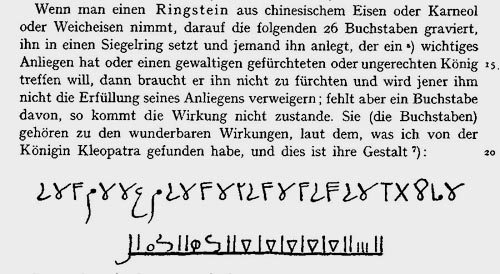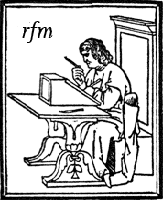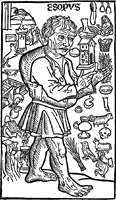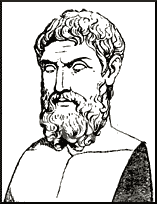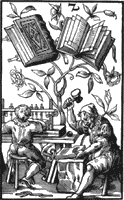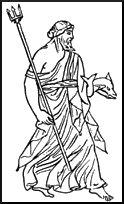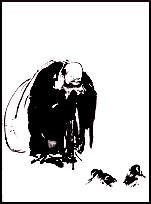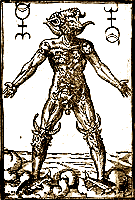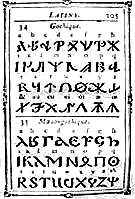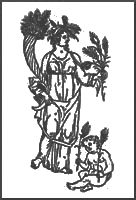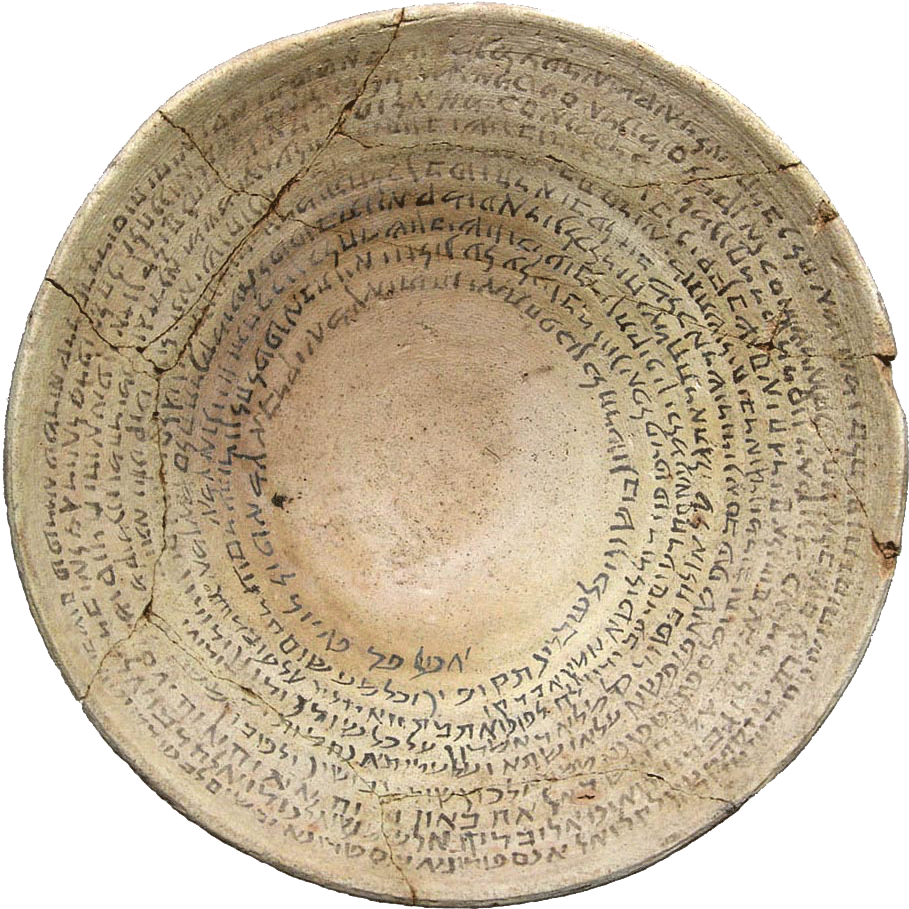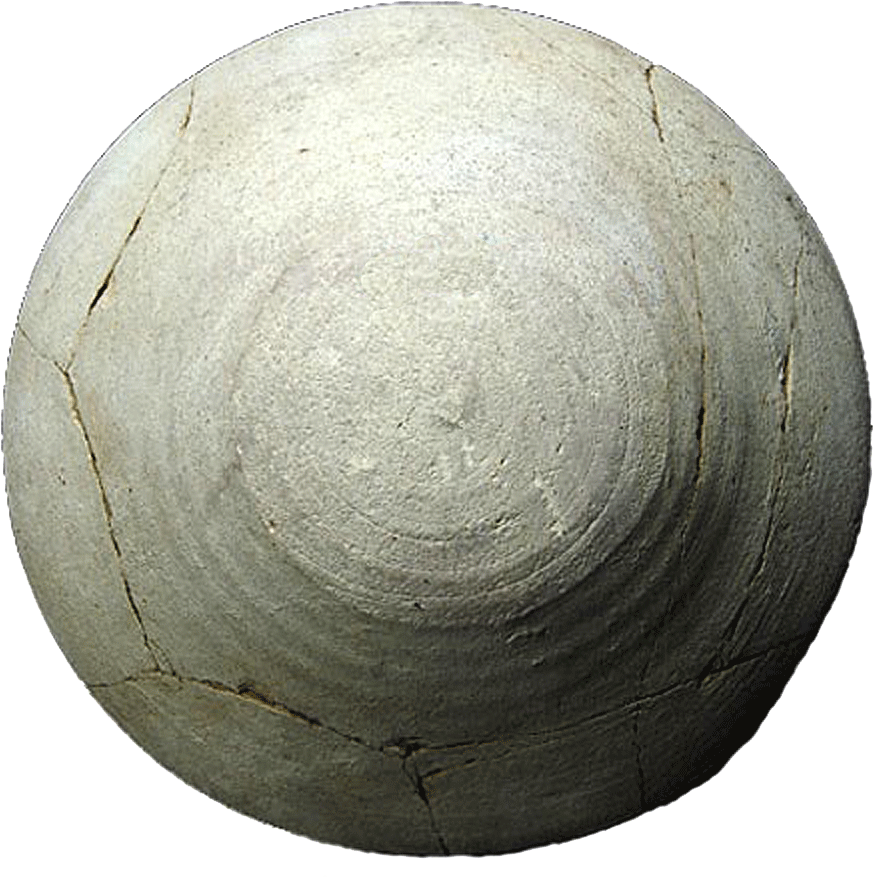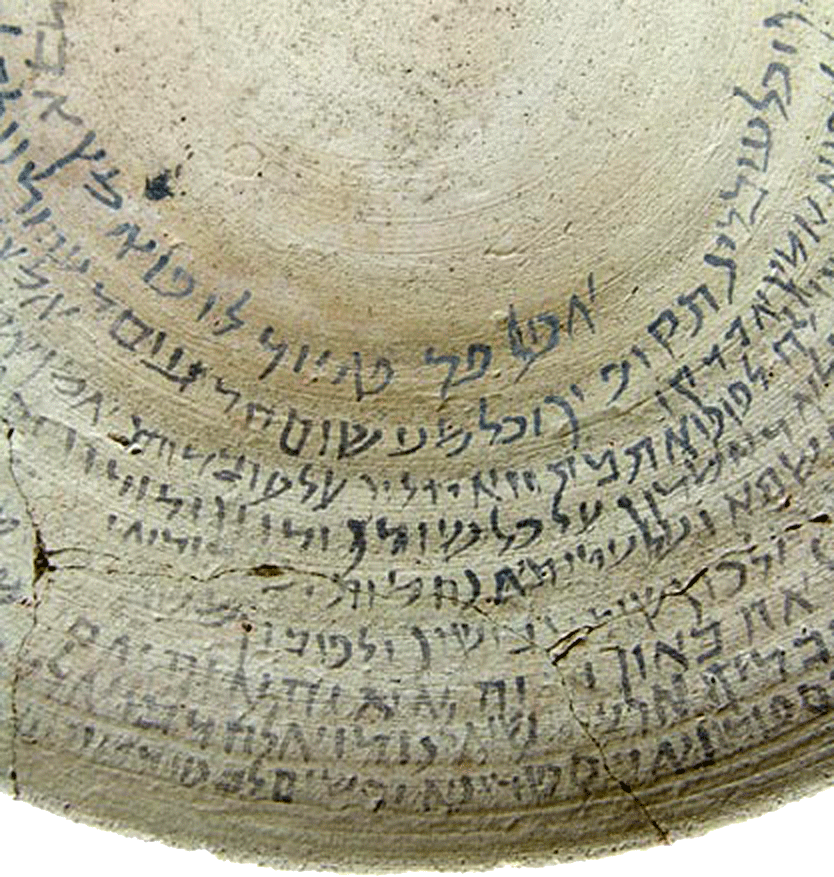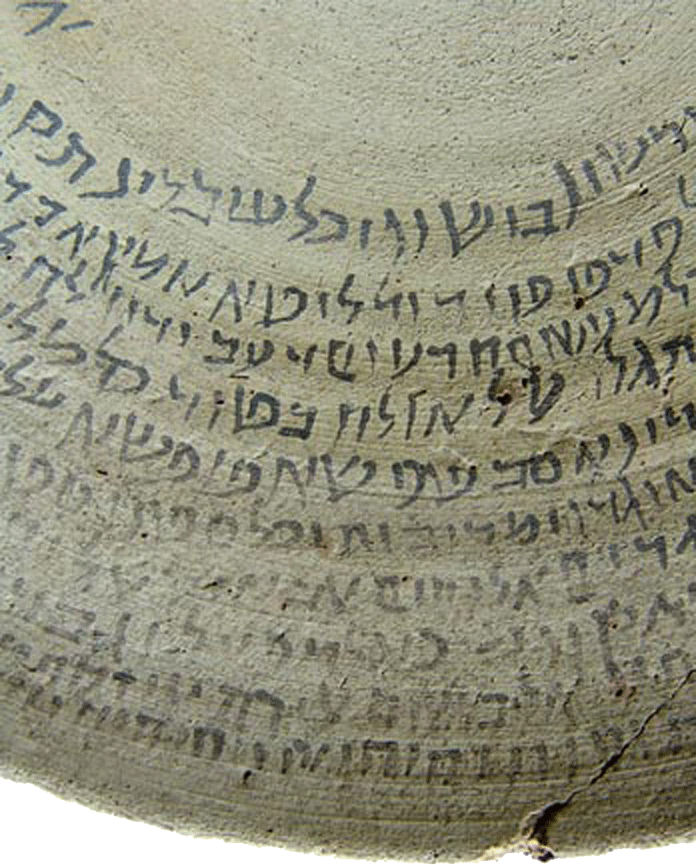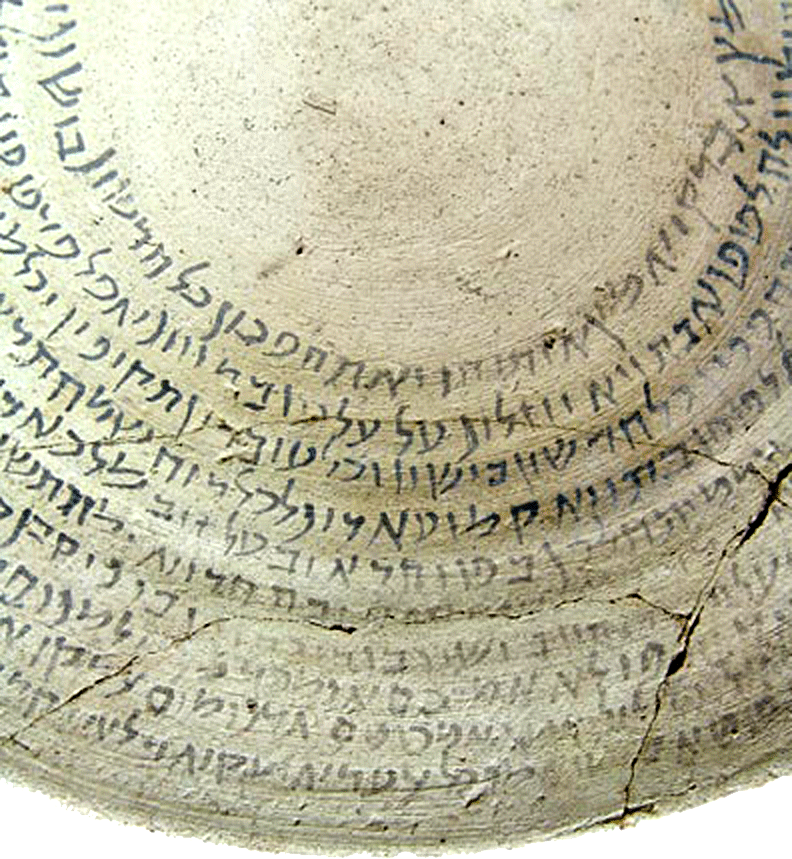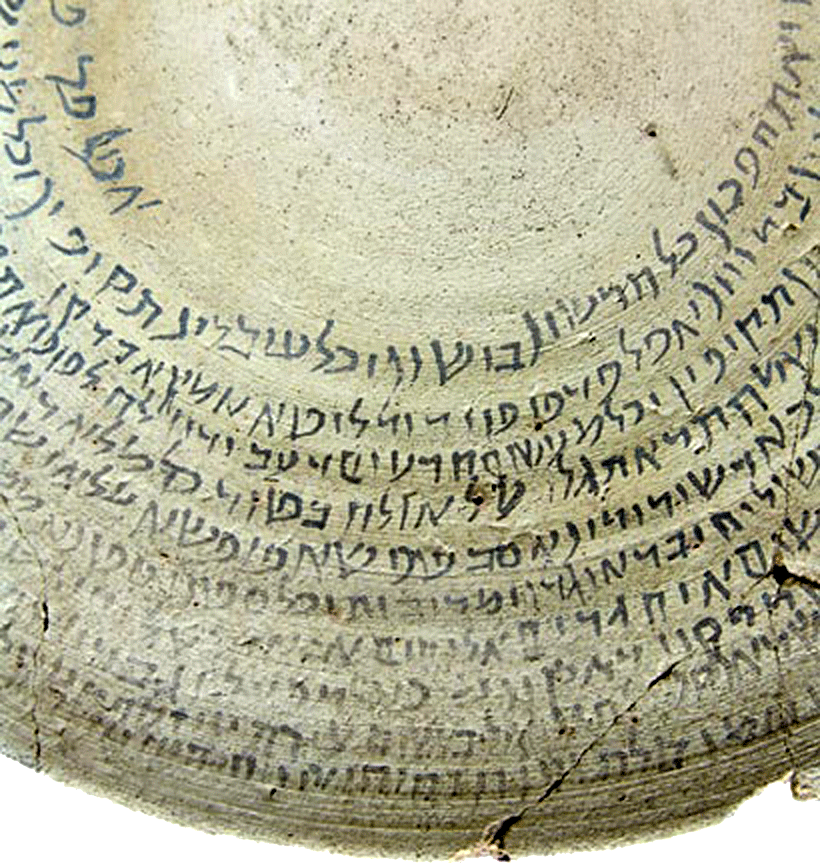Incantation Bowl, inscribed in Jewish Aramaic square script
Incantation bowl
Aramäische Beschwörungsschale
Incantation Bowl, Sassanid Empire, 5th-8th century c.e.
Pottery, grayish yellow clay, hemispherical with round bottom. Diameter ca. 169 mm, height ca. 61 mm.
The bowl is inscribed in Jewish Aramaic square script, written with a reed pen and black ink within the bowl, spiraling clockwise from the bottom upwards to the rim. The text repeals the sorceries and evil deeds that had been done to Tata, daughter of Wia or Zya, to those who made them. The spell starts with some magical names, and continues with “may all evil sorceries and powerful acts and all the evil deeds that have been done to Tata daughter of Wia go upon those who made them .... [repeated] ... amen amen sela. This amulet is for Tata daughter of Wia ....” The text proceeds to curb a wide variety of maledictions that include also types of fevers and the roof demon that is related to epilepsy.
¶ “Magic bowls are a type of amulet consisting of an incantation written on an earthenware bowl. (…) The incantations are most commonly written in black ink within the bowl, spiraling from the bottom upwards. (…) the most common form of using magic bowls was to bury them upside down under the floor of the house.” (Levene, pp. 2-3). During the Sassanian period there were numerous Jewish settlers living in Babylonia. Jewish influence is pronounced in the Aramaic language of the incantations. The scribes may have been Jewish or trained by Jews, and the Hebrew Bible is frequently quoted. The bowl texts display a variety of different styles of script. “The grammatical phenomena (…) can for the most part be exemplified from the Babylonian Talmud, and like the latter they present various dialect types. On the one hand they have close connections with Mandaic and on the other they show Syriac idioms” (J.A. Montgomery: “Aramaic Incantation Texts from Nippur”. “The Museum”, vol. III, 1913, p. 30).
¶ “Such bowls have a rather narrow chronological range. Based on the script of the text, comparisons with other pottery, and the context of those found in situ, they appear to have been in fairly popular use from the fifth to the eighth centuries C.E.” (Michael G. Morony: “Magic and Society in Late Sasanian Iraq”. In: Scott Noegel & al.: “Prayer, Magic, and the Stars in the Ancient and Late Antique World”. Pennsylvania State University Press, 2003. p. 83)
¶ “To begin with the physical variables, these bowls vary in size, shape, and type of clay. They average sixteen centimeters in diameter by five centimeters in depth, although some are twenty centimeters or more in diameter. In shape they are either hemispherical with round or flat bottoms (Type 1), or truncated cones with flat bases and vide flaring rims (Type 2). There appear to be about four times as many hemispherical bowls (162 out of 203, 80 percent) as there are flat-bottomed, flared-rim bowls (41, 20 percent). The clay is either rather lightweight and pinkish beige or fairly dense and grayish yellow-green. There appear to be somewhat more of the latter (57 percent of 280) than of the former (38 percent). They also vary in their surface design, with the presence or absence of geometric designs, the images of bound demons or of sorcerers with their arms raised. The writing on each can be organized in a spiral, concentric circles, registers, or radii and may be read in some cases by turning the bowl clockwise and in others counterclockwise. There are also differences in language and script: the tests on extant bowls are in rabbinic Aramaic, Mandaic, Syriac, Middle-Iranian, and Arabic. The fact that these languages are written in different scripts contributes to the visual difference among these bowls. Nevertheless, the texts written on these bowls are viewed as constituting a genre because of what they have in common: a set of shared assumptions about the causes of evil and how to avert it. The content of these inscriptions reveals traditions going back to Neo-Assyrian and Babylonian protective rituals and therapeutic magic.” (Ibid., pp. 84-86)
¶ “For instance, out of a sample of 411 bowl texts (both published and unpublished), nearly twothirds are Aramaic (62 percent), while most of the rest are divided between Mandaic (23 percent) and Syriac (13 percent) (…) There does not seem to be any correlation between the language and the shape of the bowl. (…) Between the language and the type of clay, correlations vary in significance. A slight majority of Aramaic bowls are grayish rather than pinkish, but the difference is less than that of the overall sample, while a substantial majority of Mandaic bowls are pinkish rather than grayish, which is the opposite of the overall sample. (…) Whether the bowl’s text is written in a spiral, circular, or radial pattern or in registers, the bowl must be turned in order to read it easily, presumably in the same direction it was turned when it was written. Every legible bowl turns either clockwise or counterclockwise, and turning the bowl my have beeen part of the magical ritual.” (Ibid., pp. 93-94)
¶ “But when they have been found in situ, they usually have been either under a threshold or built into the wall of a house or in a cemetery. (…) Incantation bowls are usually found turned upside down, sometimes with two or more bowls stacked on top of each other, less frequently in pairs, with an upper bowl inverted over an upright bottom bowl.“ (Ibid., p. 95)
Restored from several fragments. Clearly visible text, some areas near the rim slightly faded, but still readable.
Unikat. Cf. Dan Levene: A Corpus of Magic Bowls. Incantation Texts in Jewish Aramaic from Late Antiquity. London: Kegan Paul, 2003.
Hellmut Ritter & Martin Plessner:
„Picatrix“. Das Ziel des Weisen von Pseudo-Maǧrīțī. Translated into German from the Arabic by Hellmut Ritter and Martin Plessner.
London: The Warburg Institute, University of London, 1962.
Gr.Octavo. [2 weiße], [8], lxxviii, 435, [1 weiße] Seiten. Mit zahlreichen schematischen Zeichnungen im Text.
Original-Leinwandband mit braungeprägtem Titel auf Rücken und Vorderdeckel.
Mit einem Vorwort von G. Bing, einer Einleitung von M. Plessner sowie einer Einführung von H. Ritter. Eine inhaltliche Zusammenfassung von M. Plessner ist der Übersetzung vorangestellt. Diese Texte sind in Englisch, die Übersetzung der vier Bücher des „Picatrix“ ist in deutscher Sprache. Wichtiges Bindeglied zwischen den hermetischen Schriften der Antike zu den hermetischen und magischen Arbeiten der Renaissance. Agrippa von Nettesheim und anderen diente das Werk als Fundgrube.
Erste Ausgabe. „Studies of The Warburg Institute, Edited by G. Bing, Vol. 27“. Wuttke 1188.

